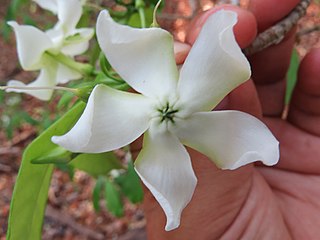
Apocynaceae is a family of flowering plants that includes trees, shrubs, herbs, stem succulents, and vines, commonly known as the dogbane family, because some taxa were used as dog poison. Members of the family are native to the European, Asian, African, Australian, and American tropics or subtropics, with some temperate members. The former family Asclepiadaceae is considered a subfamily of Apocynaceae and contains 348 genera. A list of Apocynaceae genera may be found here.

Tabernaemontana is a genus of flowering plants in the family Apocynaceae. It has a pan-tropical distribution, found in Asia, Africa, Australia, North America, South America, and a wide assortment of oceanic islands. These plants are evergreen shrubs and small trees growing to 1–15 m tall. The leaves are opposite, 3–25 cm long, with milky sap; hence it is one of the diverse plant genera commonly called "milkwood". The flowers are fragrant, white, 1–5 cm in diameter.

Voacangine is an alkaloid found predominantly in the root bark of the Voacanga africana tree, as well as in other plants such as Tabernanthe iboga, Tabernaemontana africana, Trachelospermum jasminoides, Tabernaemontana_divaricata and Ervatamia yunnanensis. It is an iboga alkaloid which commonly serves as a precursor for the semi-synthesis of ibogaine. It has been demonstrated in animals to have similar anti-addictive properties to ibogaine itself. It also potentiates the effects of barbiturates. Under UV-A and UV-B light its crystals fluoresce blue-green, and it is soluble in ethanol.

Ibogamine is an anti-convulsant, anti-addictive CNS stimulant alkaloid found in Tabernanthe iboga and Crepe Jasmine . Basic research related to how addiction affects the brain has used this chemical.

Tabernaemontana donnell-smithii is an evergreen tree in the dogbane family Apocynaceae commonly known as the horse balls tree. In Spanish, it is huevos de caballo, cojones de burro, cojón de mico, or cojotón. The name, huevos de caballo, comes from the oval shape of the tree's hanging fruit. It is native to Mexico and Central America. The type locality is San Felipe, Retalhuleu in Guatemala. Tabernaemontana donnell-smithii is similar to Tabernaemontana glabra, except that its leaves and flowers are smaller and its fruit is larger.
Tabernaemontana glabra is an evergreen tree from the family Apocynaceae, native to Mexico, Central America, and northwestern South America. It is similar to Tabernaemontana donnell-smithii, except that its leaves and flowers are larger and its fruit is smaller.

Tabernaemontana divaricata commonly called pinwheel flower, crape jasmine, East India rosebay and Nero's crown is an evergreen shrub native to South Asia and now cultivated throughout South East Asia and the warmer regions of continental Asia. In zones where it is not hardy it is grown as a house/glasshouse plant for its attractive flowers and foliage. The stem exudes a milky latex when broken, whence the name milk flower.

Tabernaemontana crassa is a plant in the dogbane family Apocynaceae, native to tropical Africa.

Tabernaemontana pandacaqui, known as windmill bush and banana bush, is a species of plant in the dogbane family Apocynaceae.
Tabernaemontana alba, the white milkwood, is a species of plant in the family Apocynaceae. It is found in Central America, Mexico, Florida, Cuba, and Colombia.

Tabernaemontana amygdalifolia is a species of plant in the family Apocynaceae. It is native to southern Mexico, Central America, Cuba, Haiti, and northwestern South America.

Tabernaemontana catharinensis is a species of plant in the family Apocynaceae. It is found in southern South America.

Tabernaemontana flavicans is a species of plant in the family Apocynaceae. It is found in northwestern South America.

Tabernaemontana heterophylla is a species of plant in the family Apocynaceae. It is found in southeastern Central America, and northern and central South America.
Tabernaemontana linkii is a species of plant in the family Apocynaceae. It is found in northern and western South America.
Tabernaemontana siphilitica is a species of plant in the family Apocynaceae. It is found in northern South America.

Apparicine is a monoterpenoid indole alkaloid. It is named after Apparicio Duarte, a Brazilian botanist who studied the Aspidosperma species from which apparicine was first isolated. It was the first member of the vallesamine group of alkaloids to be isolated and have its structure established, which was first published in 1965. It has also been known by the synonyms gomezine, pericalline, and tabernoschizine.
Deltostethus columbiensis is a species of water scavenger beetle in the family Hydrophilidae. It is found in Central America and North America.
Ochthephilus columbiensis is a species of spiny-legged rove beetle in the family Staphylinidae. It is found in North America.

Tabernaemontanine is a naturally occurring monoterpene indole alkaloid found in several species in the genus Tabernaemontana including Tabernaemontana divaricata.













